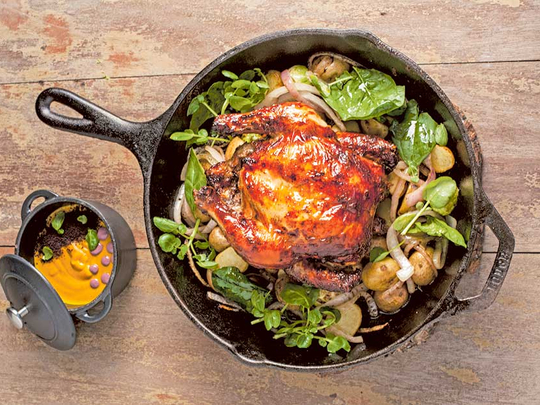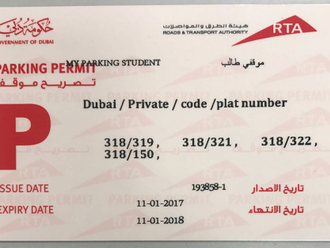
Jaimie Pesaque’s Peruvian restaurant in Dubai isn’t just a place to eat. It’s a cultural embassy for the South American nation, which celebrates its independence day on July 28.
Mayta, which opened earlier this year in the same building as the Capital Club in Dubai International Financial Centre, is Pesaque’s second outlet, after one in his home country’s capital, Lima. The word means “noble land” in Aymara, one of Peru’s three official languages.
“It’s about being thankful to our land,” says Pesaque, seated in the brightly coloured, yet chic interior of the restaurant. “We are thankful to our country. I realised it’s not just a restaurant, it’s a small embassy.”
Chifa, or Chinese-style, ceviche.
That makes Mayta sound very serious, and while the food there is incredible, and thoughtful, it’s also a lot of fun. There’s a separate bar area, serving up dance-inducing variations on the national cocktail, lounge-style tables, and a long ceviche bar, where chefs whip up plates of the seafood delicacy in front of your eyes. (Or as Pesaque puts it, “you can smell the limes”.)
Cooking up Peruvian dishes, such as ceviche and lomo saltado, requires a host of ingredients you won’t find at your local supermarket, which is why Pesaque ships in many of the items himself, from a dozen kinds of chilli (including the key one, aji amarillo), fruit, Amazon tomatoes, potatoes, quinoa and grains, limes and different types of corn, dried, and fresh. The kitchen calls itself “artisanal”, with a focus on cooking dishes from scratch.
“We try to bring as much as we can, so we can then give our customer our truth,” the chef adds. He recalls a customer at another of his restaurants outside Peru, who had never had Peruvian food or even heard of the country before he had dinner there. “He came four days after that, and he told me, ‘you know what? I just bought for me and my family, tickets to Peru.’ And I was so happy. I said, OK, we are doing something for our country.”
Many others are also doing something for Peru in Dubai — there are at least half a dozen restaurants in the city. What sets Mayta apart?
“I have been in some Peruvian restaurants, I don’t like to compare. The only thing I can say is this is a brand from Peru, I am from Peru, I put a lot of passion, I think we are bringing our truth.”
But it is safe to say that the cuisine — with its mix of tangy limes, spicy chillis, seafood, meat and potatoes — has found global popularity. Why have people embraced this cuisine?
“Peru is growing in the market as a country, in general. Beside that, I think that now the world sees us. Peru is rich in gastronomy... we are a small country, we have an ocean, the coast, and the rainforest that is the Amazon. We have a lot of products because of this. We are rich in products, and even now, we didn’t discover everything. We are passionate about food. Being a cook in Peru is easy — the country does the work for you.”
The country is also a hotbed of fusion cooking, in the best way, with influences from Japanese, African and Chinese cuisines evident in dishes such as tiradito — a sashimi-style raw fish ceviche — or lomo saltado, which is a wok-fried dish of beef, soy sauce and French fries. (Yes, French fries. And Mayta’s version is one of the best things I’ve eaten — ever.)
What to eat at a Peruvian restaurant: Jaimie Pesaque talks us through the menu
If you’ve never eaten Peruvian food, first of all know that it’s ridiculously delicious, with its mix of fresh and tangy flavours alongside hearty meats and potatoes. Oh, yes, and quinoa, of course. Choose a couple of ceviches, a couple of tiraditos and anticuchos, a wok dish and a “big share” meat main for a table for two.
Ceviche: “We want to be storytellers of what happened,” says Pesaque in describing the dishes on his menu. “In ceviche, there is the Puro, the first one we made. [Peruvians] used to cook it in lime, from 9am to 2pm, and we ate it like that before, and it was overcooked. Then the Japanese arrived and showed us we could eat it raw. It’s pure, not too many ingredients. Then there is the Chifa, the story of a ceviche, but with influence from China. 500 years ago a lot of Chinese people came to Peru. Then the mixto: the fisherman would chop this chile that grows by the coast; thinking of that we made this ceviche.” The dish, of raw seafood such as tuna, seabass, salmon and corvina, is prepared to order, and eaten right away. “It stays in the bowl for under a minute. It changes a little bit of the colour. Ceviches must be cold.”
Anticuchos: “That’s the story of Peruvian street food. I want to have a little bit of everything in our culture. They are skewers, marinated in sundried chile, a little bit of vinegar, soy sauce. We make different ones with prawn or with [veal] heart — that’s the more traditional one. We put it on the charcoal grill, and it’s lovely and smoky.”
Tiraditos: “This is like sashimi-style, it’s similar to eating ceviche.”
Wok: “This is an influence from china, and I think it’s really important to have it. All of these Chifas [Peru’s Chinese restaurants] have a wok. Lomo saltado is one of the most traditional [dishes]. Chaufa is like fried rice, Peruvian style, and there’s a quinoa version.”
Grills: “Pollo amazonas is Amazon-style chicken that we marinate in a root from the Amazon that we bring here, and cook in plantain leaves.”
Dessert: Suspiro — the word means the breath you take “when you see a lady and she’s so beautiful”. “It’s Peruvian dulce de leche with egg yolks. That’s the most classic one.” It comes with a light-as-air meringue.










